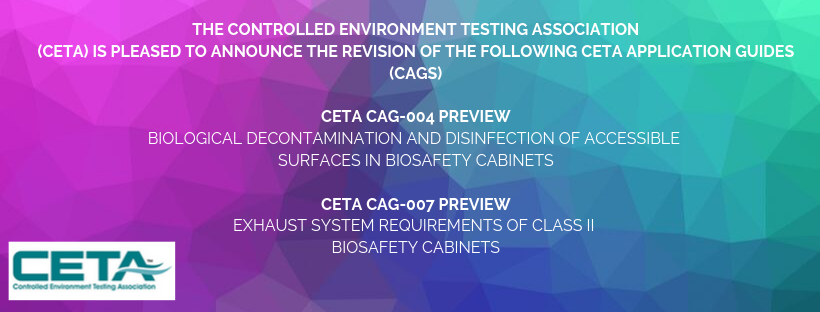CAG Announcement #1 as of 10/1/2019
The Controlled Environment Testing Association (CETA) is pleased to announce the revision of the following CETA Application Guides (CAGs). To view the CAGs (members only), click here.CETA CAG-004 Preview Biological Decontamination and Disinfection of Accessible Surfaces in Biosafety Cabinets This CETA Application Guide revision (September 2019) builds on the technical information presented in the original CETA CAG-004-2007 (January 30, 2007) that provided technical information on various liquid chemical disinfectants for use in surface disinfection (decontamination) of BSCs. The completely rewritten Application Guide provides robust and updated guidance for the certifier, safety officer, or user in the use of chemical disinfectants to biologically disinfect (decontaminate) the readily accessible areas of Biological Safety Cabinets (BSCs). The guide includes:
CETA CAG-007 Preview Exhaust System Requirements of Class II Biosafety Cabinets This CETA Application Guide revision (September 2019) builds on the technical information presented in the original CETA CAG-007-2010 (March 24, 2010) that provided technical information on the special requirements for connecting Biological Safety Cabinets (BSCs) to building exhaust systems. The completely rewritten Application Guide provides robust and updated guidance for the certifier, safety officer, or user to understand these requirements. "When Class II Biological Safety Cabinets (BSCs) are connected to building exhaust systems, there are special requirements that set them apart from chemical fume hoods and other exhausted laboratory devices. This guide is intended to help the reader understand what those special system requirements are and how a BSC should be properly connected to a building exhaust system. The guide discusses exhausted BSC operation, BSC exhaust system connection types, testing and balancing methods for exhaust systems connected to BSCs, and gives detailed specifications on the type of valves, dampers, and duct sampling holes needed for successful and reliable operation. This guide is meant to be used in conjunction with NSF standard 49 Annex E and be used by facility operators, biosafety cabinet users, biosafety officers, mechanical engineers, lab managers and architectural firms and field certification companies. " |



